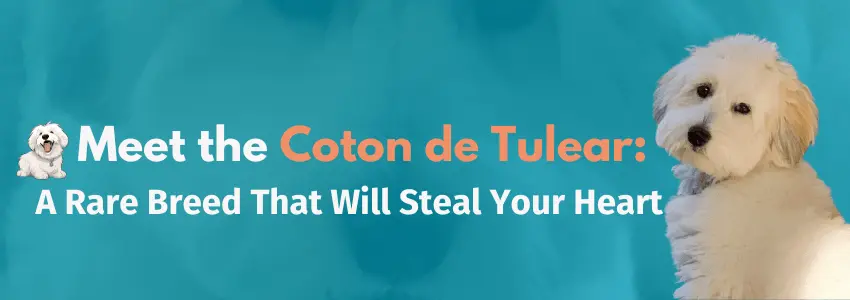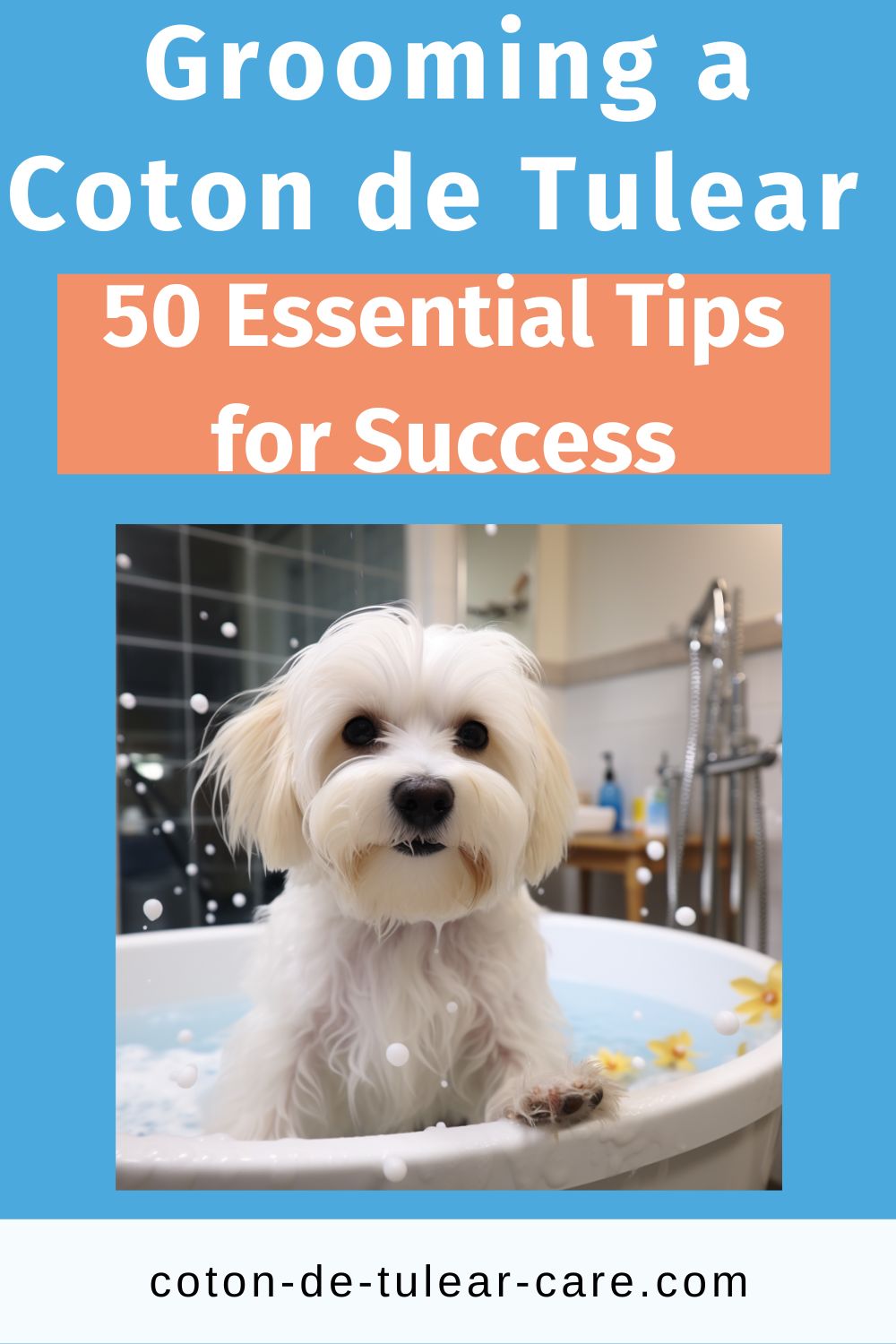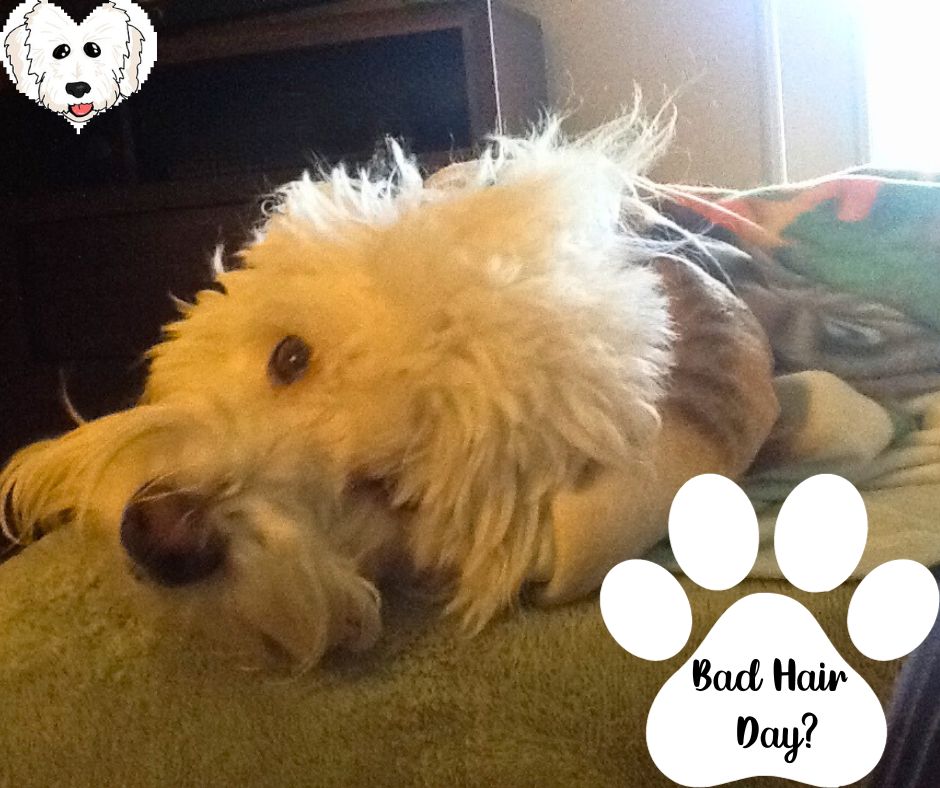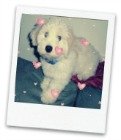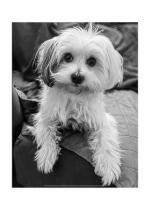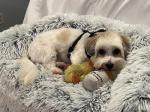Grooming a Coton de Tulear:
50 Things You Need to Know
Grooming a Coton de Tulear doesn't have to be a frustrating or challenging task for pet owners. Here are some tips to simplify grooming for this beautiful dog breed.
Coton de Tulear General Coat Care
Whether you groom your Coton yourself or go to a professional groomer, a little knowledge goes a long way! Dive into these game-changing tips to simplify your grooming routine and elevate your Coton's health and dazzle factor.
No. 1 - Cotton-like Coat: The Coton's coat resembles a cotton ball, hence the name. They have a soft, cottony coat type that requires gentle handling.
No. 2 - Daily Brushing: Unlike some breeds, the Coton often needs daily brushing if they're sporting the standard long-haired coat they're known for to prevent matting. But if you keep your Coton in a shorter cut like a summer cut or puppy cut, regular brushing is usually only necessary 2 to 3 times a week or as needed. Note that if your Coton is in the coat-changing phase when the adult coat is coming in, you will need daily brushing to keep the mats at bay no matter how short their hair is.
No. 3 - Avoid Over Bathing: Too many baths can strip natural oils. Maintaining the entire coat if you over-bathe can be challenging,
No. 4 - Always Use a Grooming Spray: Spray before brushing so you don’t damage their hair. Your dog will thank you because there will be less pulling.
No. 5 - Non-shedding Dog: Since the Coton is a single-coated breed, they don’t shed like other dogs. While there’s no such thing as a 100% non-shedding dog, they shed very minimally.
No. 6 – Mostly Hypoallergenic: There’s no such thing as a totally hypoallergenic dog, but because they don’t shed much, they are often great choices for people with dog allergies.
No. 7 – Don’t Get Lazy: Grooming will be easier, and there will be less matting if you keep your dog clean and brushed consistently.
As an Amazon Associate, I earn from qualifying purchases which allows me to run this site and provide in-depth content at no extra cost to you.
Grooming a Coton de Tulear at Home
Professional grooming is often necessary for the best results, especially if you’re part of a breed club or showing your Coton de Tulear. But if you are sure you want to take on the job yourself, here are some important DIY tips to make grooming more manageable and safer.
No. 8 - Build a Routine: A regular grooming routine will keep your Coton clean and comfortable, and can make the grooming process more enjoyable for you and your dog.
No. 9 - Bathing Frequency: They don't need frequent baths; once a month is often sufficient to maintain a clean coat. A poll on this website showed that most people bathe their Cotons every 2 to 4 weeks. This will vary depending on your dog’s age, health, and lifestyle.
No. 10 - Avoid Human Shampoo: Always use dog-specific shampoo, as human shampoo can be too harsh. There are so many choices available at various price points. Our visitor recommendations can be found here. You can narrow down the search by choosing non-toxic, gentle, and chemical-free shampoos.
No. 11 - Conditioner Helps: A good conditioner can make brushing easier. You should ALWAYS condition the hair after shampooing! One of my new favorite conditioners is Lisa's Conditioner because it's plant-based, vet-approved, and has no harmful icky ingredients!
No, 12 - Avoid Blow Drying on High Heat: High heat can damage their coat. Use a blow dryer with adjustable heat settings and cool settings. You can also use a professional blower like the ones used in grooming salons, which will speed up the drying process.
No. 13 - Avoid Sharp Scissors Near Face: Safety is paramount, especially near the dog’s face.
No. 14 - Avoid Fragrance: Fragranced grooming products can irritate their skin. Opt for hypoallergenic breed-friendly products that are non-toxic.
No. 15 - Avoid Rushing: Take your time; rushing can cause stress and mistakes.
No. 16 - Use a Grooming Table: A grooming table can make the process easier and is a must if you plan to groom yourself at home. Get your puppy used to the table right away. Start with a minute or two and then gradually increase the time. And, of course, NEVER leave your dog unattended on the table.
No. 17 - Dry the ears completely: Cotons, like most long floppy eared dogs, can get frequent ear infections. You can mitigate this by keeping their ears clean and completely dry after bathing.
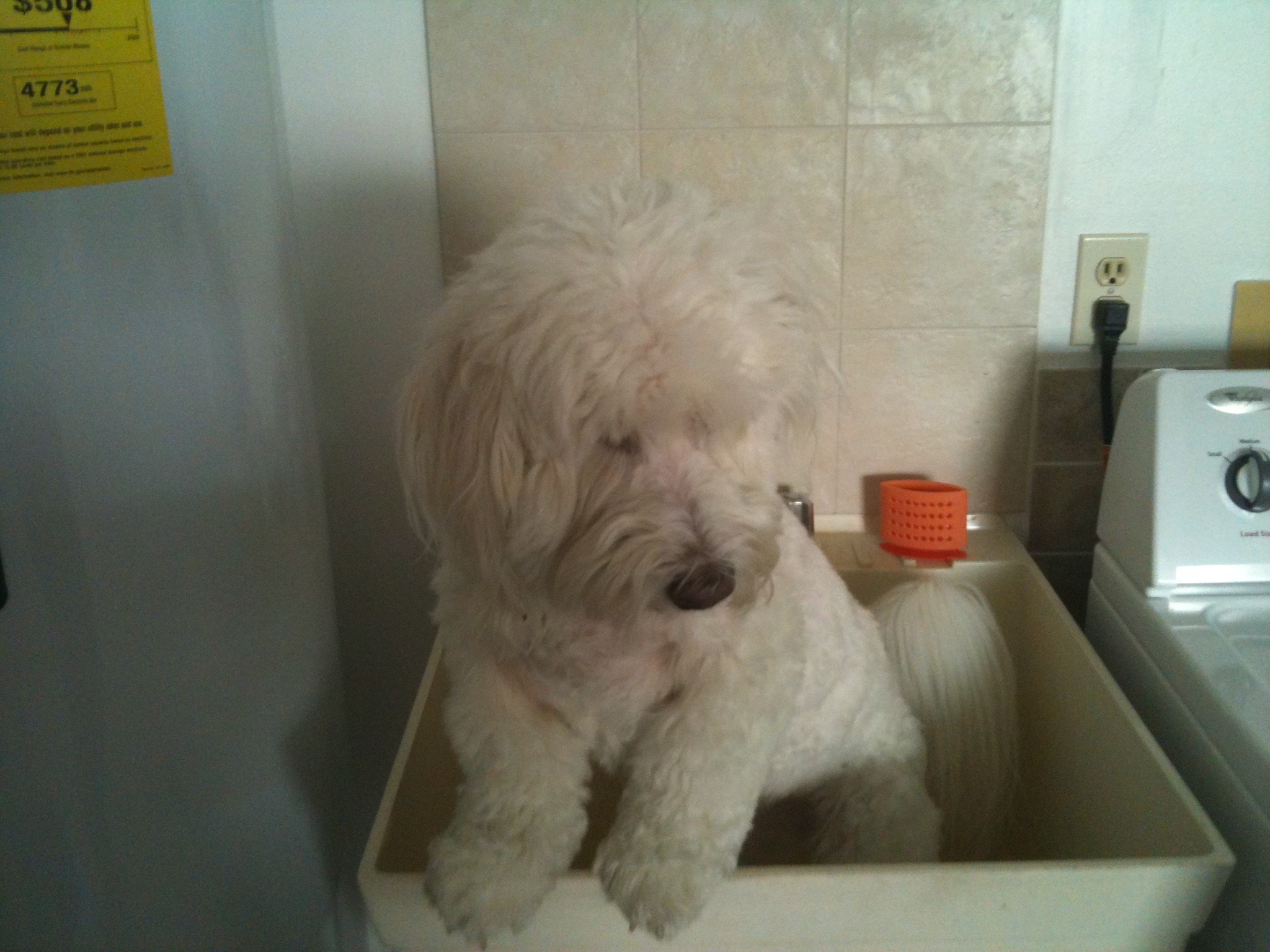
Common Coton de Tulear Grooming Problems & Solutions
No. 18 - Tear Stains: Regular cleaning around the eyes can prevent eye stains, which are common in most white dogs. High-quality food and spring water also help prevent staining. Learn how our visitors deal with tear stains here.
No. 19 - Puppy Coat Transition: The coat changes from the puppy coat to their adult hair between 6 and 14 months, requiring different care. This is often referred to as “blowing their coat." During this time, your Coton’s coat will be more challenging to maintain and will often develop mats. Many people find that keeping their dogs in a puppy cut is more manageable during this coat change period. Daily brushing is essential during this period no matter how short the hair is.
No. 20 - Brush before bathing to prevent mats: Brushing your dog before bathing significantly reduces the tendency to mat. It’s virtually impossible to remove mats from a wet dog!
No. 21 - Avoid a Wet Environment: Keeping them dry helps prevent matting. Remove excess water promptly.
No. 22 - Use Detangling Spray: A detangling spray can make brushing easier and help with matted hair. This is especially useful for adult dogs. Avoid using silicone sprays because they’re super hard to wash out.
No. 23 - Diet Affects Coat: A healthy, high-quality diet helps maintain a beautiful full coat and reduces coat staining. Avoid highly processed foods and ingredients such as beets, tomatoes, corn, wheat, red meat, soy, artificial colors, preservatives, and dairy products. Any food that causes allergies in your dog can cause tear staining.
No. 24 - Avoid Alcohol-based Products: Alcohol can dry out the skin.
No. 25 - Don’t Over-Trim: Over-trimming can lead to an uneven coat.
No. 26 - Fleas and ticks: Regular checks for fleas and ticks are part of grooming. A flea comb can be used as part of the regular grooming session. Be careful with shampoos and products that have toxic chemicals. My dog uses Wondercide products – they’re toxin-free, and they work!
No. 27 - Grooming an Anxious Dog: Don’t worry if your dog is not a fan of grooming or gets stressed out when it’s bath day or when you reach for the brushes. Learn more from this article on how to groom your anxious dog to make life easier for you and your dog.
Coton de Tulear Grooming Tools
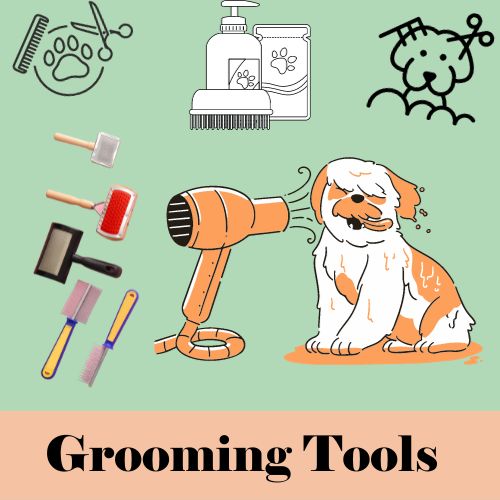
Let's be real – equipping yourself with the right brushes, combs, and tools for your Coton's coat is an investment. There can be sticker shock when you see the price tag just for a brush! While the initial cost might give you pause, think of it as saving money in the long run. Trust me, I've tossed out more ineffective grooming gadgets than I care to admit, and that adds up.
No. 28 - Use a Wide-tooth Comb: A wide-tooth comb or poodle comb is often more effective in detangling their hair. These are great for combing through thick coats and checking for mats.
No. 29 - Use the Best Brushes: A slicker brush or Chris Christensen brushes can help remove loose hair and prevent matting. They help create fluffiness and straighten the hair after a bath. A pin brush is gentle and keeps long hair silky. It is a good choice for brushing their tail, top knot, ears, and long body hair.
No. 30 - De-matting tools: Unfortunately, almost all Cotons will get mats at some point. Having the proper tools on hand will help get mats under control before you have to go to extreme routes such as shaving. Mat splitters and detanglers are a must.
No. 31 - De-matting Solutions: Cowboy Magic is one of the most recommended by our site visitors to help remove matting, with Ice on Ice being the second favorite de-matting product.
Coton de Tulear Skin
No. 32 - Sensitive Skin: Coton skin can be more sensitive than other breeds, so gentle grooming products are a must to avoid skin irritation.
No. 33 - Regular Skin Checks: Regular vet checks can catch skin issues or any medical condition early. And you can check yourself during daily grooming. Massages are also great for finding any problems, and your dog will love you for it.
No. 34 - Sunscreen: Their skin can be sensitive to the sun, so dog-specific sunscreen might be needed.
No. 35 – Itchy Dogs: If your dog constantly scratches or licks its paws, it may have an allergy. Finding the root cause of dog allergies can be frustrating, but you can narrow down whether your dog has food or environmental allergies. You can learn more about skin problems here.
Coton de Tulear Basic Grooming Tips
No. 36 - Start Early: Get your puppy used to grooming right away. The earlier you start grooming puppies, the sooner they’ll get used to it, and it will become as natural as begging for food or chasing balls.
No. 37 - Don’t Forget the Ears: Dogs need their ears cleaned just like people, so you should make it part of their regular grooming routine. Regular ear cleaning is essential to prevent infections. Ear canal care is crucial as Coton de Tulear ears are long and floppy, a place for bacteria to collect. Smelly ears are a sign that ears may need attention from a vet.
No. 38 - Nail Trimming: Your dog's nails grow quickly, so regular trimming is necessary. Keep Styptic powder on hand in case of any accidental nicks. You can have your groomer cut your dog’s nails if you’re squeamish about doing this yourself.
No. 39 - Grooming Wipes: Grooming wipes can be handy for quick clean-ups. Wipe paws whenever your dog comes in the house from outside where they pick up all kinds of dirt and chemicals from grass. Select wipes that are non-toxic without harsh chemicals.
No. 40 - Regular Dental Care: Brushing their teeth is part of grooming and promotes overall health. Learn more here
No, 41 - Tail Grooming: Tail grooming is essential to prevent matting. Check out this one-minute video for tips.
No. 42 - Paw Care: Regular paw care includes trimming hair between the pads. Also, pay special attention to the front leg and back legs. It’s a good idea to regularly check paws for injuries so you can catch issues early.
No. 43 - Regular Eye Checks: Regular eye checks can prevent issues related to lashes and lids.
No. 44- Check Anal Glands: Regular checks can prevent discomfort and health issues.
No. 45 - Avoid Overheating: Overheating during grooming can cause stress.
No. 46 - Use Organic Products: Organic, non-toxic products align with a healthy lifestyle and ensure your dog isn’t getting harsh or toxic ingredients.
No. 47 - Avoid Tight Collars During Grooming: Tight collars can cause discomfort.
No. 48 - Avoid Silicone-based Products: Silicone can weigh down their coat.
No. 49 - Don’t Over Condition: Too much conditioner can make the coat greasy.
No, 50 - Use a Grooming Apron: A grooming apron protects you and makes grooming easier.
Don’t get overwhelmed by the above tips. You don’t have to do all of these things at once. Take baby steps. And ask for help if you have questions!
Remember, every Coton de Tulear dog is unique, and it's always a good idea to consult with professional dog groomers or a veterinarian to understand the specific needs of your Coton. Different ways of grooming may suit different dogs. Proper coat care can greatly improve the life of your dog.
To learn more about Grooming a Coton de Tulear, check out these other helpful resources:
Meet the Cotons Book: Learn all things Coton, including grooming
Coton Grooming Solutions: Our visitors share their favorite solutions to common grooming problems
Coton Grooming FAQs: Ask your grooming question here
Home | About Me | Contact Me | Privacy Policy |Disclosure
Copyright© 2008- All Rights Reserved

